It is known as one of the Seven New Wonders of the world with over two million animals migrating from the Serengeti National Park in Tanzania, to the greener plains of the Maasai Mara National Reserve in Kenya. Nowhere in this world is there a movement of animals greater in scale than that of the Wildebeest Migration.
The Great Wildebeest Migration
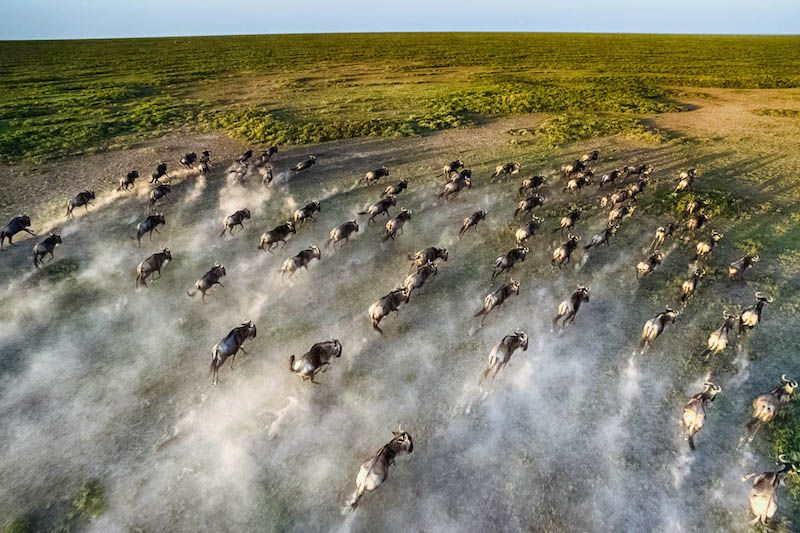 Source: Aerial photograph of migrating Wildebeest
Source: Aerial photograph of migrating Wildebeest
Moving from region to region over a twelve-month period, and in a clockwise direction around the enormous ecosystem, over two million animals including Wildebeest, Zebra and Gazelles are hugely driven by the need to find grazing and water, however these herds undergo huge challenges and even hardships as they are under continuous attacks from natural predators. Anticipating this migration are Africa’s large carnivores including Hyenas, Lions,
Leopards and Cheetah as well as the huge Crocodiles and Hippos awaiting at the various river crossings.
With over 40,000 square kilometres dominated by the migration routes of the white Bearded Wildebeests (Connochaetes tuarinus mearnsi), it includes areas of the Ngorongoro Conservation zone in the south; The Serengeti National Park, the Maswa Game Reserve and the Maasai Mara National Reserve. There is neither a start nor a finish to the migration as the animal’s endless search for food and water continues all year round, and as they circle the Serengeti-Mara ecosystem they undergo a continuous sequence of both life and death. One of the huge influences on
the migration is both the weather and the four seasons per year – The Short dry season in December-March, The Long dry season from June to September, the Long rains that fall over a six-week period from March to May, and finally the short rains that fall anytime from October to November. The herd movements however are always very different, with no two years the same it is not easy to predict their migration route.
Birthing
In January and February, the Wildebeest cows begin to calf, this event sees between 30,000 to 40,000 calves born within two to three weeks of one another making it the largest birthing sequence of any Mammal on Earth. Occurring in the southern areas are the Wildebeests, they are the fastest ungulate species that can co-ordinate onto their feet within two to three minutes after birth and are able to run with the herd when only 5 minutes old, outrunning lionesses soon after. Sadly, many calves die within their first year with only 1% dying from predation, the rest mostly die from malnutrition, fatigue or disease. When the herd panics it is very common for calves to become separated from their mothers when crossing rivers or lakes. A calf will then wander for days bleating and bawling for their mother, on rare occasions they may find her but no other cow will adopt a calf, even if she has lost her own or is lactating. As the calf begins to weaken they become easy prey for any predator including jackals.
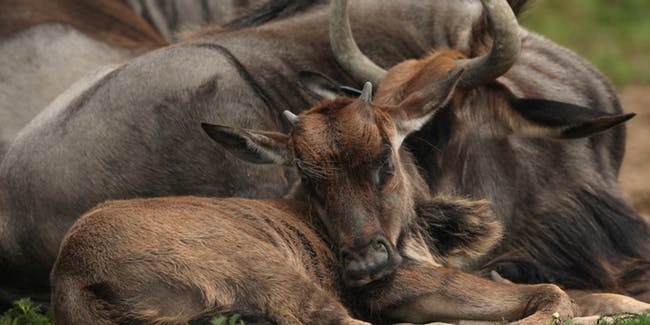 Source
Source
The Circle Beginning
At the end of the short dry season in March, the short grass begins to dry and the animals start their journey heading towards the west. You may be wondering how they know which way to go? There have been two answers found, one according to Behaviourist and Ecologist Harvey Croze suggests their journey is dictated by their response to the weather, following the rains and growth of the new grass or an instinctive knowledge written in their DNA from thousands of years of natural selection. Potentially the ones that went the ‘wrong’ way would of died from thirst and starvation and would never have reproduced.
From Olduvai, the herds will move west towards a group of lakes Ndutu, Masek and Lagaria, where they satisfy their biggest need to find water scattering widely across the plains whilst feeding on the short grass, one day they’ll be spread in the tens of thousands over Ndutu, the next day they’ll all be gone. At this point the first long rains begin to fall and the Wildebeest are seen cantering towards the thunderstorms in the distance.
Rutting begins as the rains set in and the herd has now moved north-west into the woodlands of Seronera between May and June. Within less than a month over half a million cows will have been mated.
River Crossings
Following the rains, the herds then head north into the Maasai Mara Game Reserve, however it is not plain sailing so to speak, there are many rivers that they must cross, for the most part these rivers are calm yet due to the violent rainfall in these areas resulting in flash flooding and bursting riverbanks a major obstacle is created for the migrating animals.
As they stand along the banks of the rivers, they wait for one of the herd to move forward and then their natural herding instinct will kick in to follow, the animals do have a fear of water and the creatures that may be dwelling under the surface, yet their instinct to continue forward at any cost takes over. They could walk around it easily yet they don’t, why do you ask? It is believed to be natural selection stepping in, the animals that have crossed these lakes within previous generations went on to survive and breed their offspring, so the water generally should instil no fear into the ones who did, therefore these braver Wildebeest have a greater influence on the gene pool.
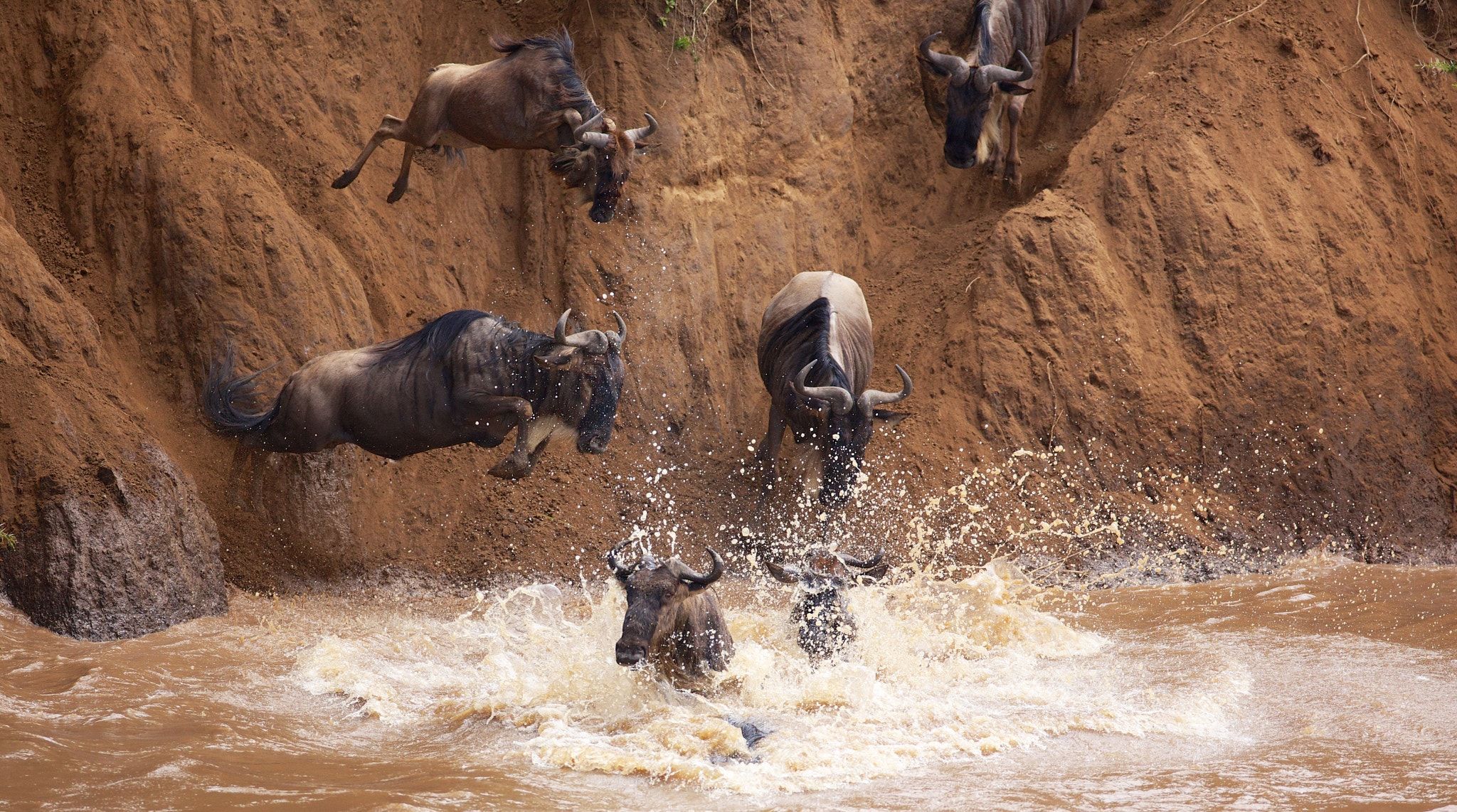 Source: With little fear, they jump into the water to get to the other side potentially for better grazing
Source: With little fear, they jump into the water to get to the other side potentially for better grazing
Tragically documented in the Year of the Wildebeest, it was described how a herd of cows crossed the lake Langarja and became separated from their calves, so they turned back, re-entering the water and swimming back to the banks.
When they did not reunite with their calf they then turned back again and crossed to the other side, this repeated over a course of seven days until the main body of the herd crossed and they were forced to move on, this caused thousands of deaths within this lake. Yet without this natural mortality of calves the population of Wildebeest would spiral massively out of control.
The Wildebeest arrive at the Mara river in their thousands gathering to cross, over the course of a few days their numbers will grow significantly and the anticipation grows yet many times they approach the water’s edge and then turn away at the last second. Looking for a placid part of the river they will also aim for areas without a lot of vegetation on the other side as this presents hiding locations for predators. Occasionally documented they will chose suicidal points and drown in their hundreds which could be because the crossing points could be imprinted on their minds.
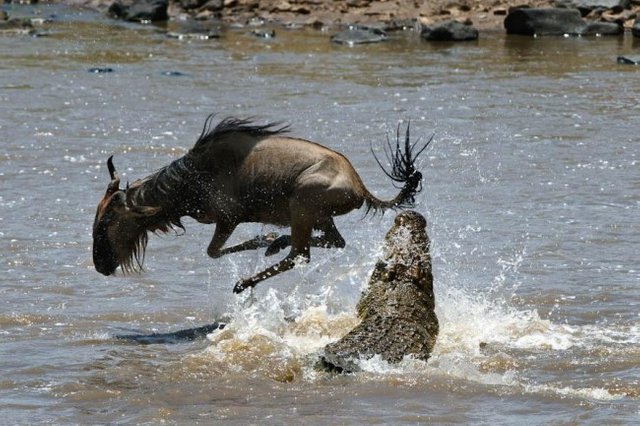 Source: a close call with a crocodile, this Wildebeest made it to the other side
Source: a close call with a crocodile, this Wildebeest made it to the other side
Circles End
In late October, the short rains begin to fall over the Serengeti’s shorter grass plains that sill the waterhole and bring a huge flourish of grass growth causing the wildebeest to move south again, they walk down through the eastern woodlands with 90% of the herds cows heavily pregnant and once again spread out upon the open plains ready to give birth once more.
Content Sources
1, 2, 3, 4






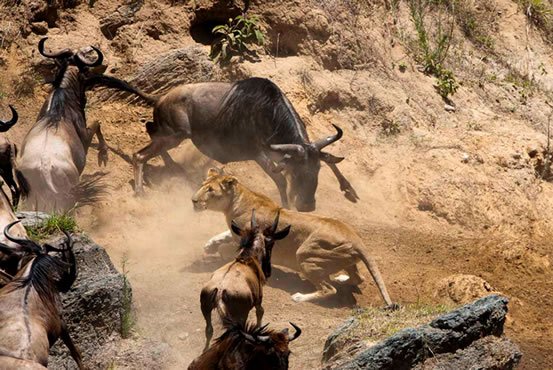

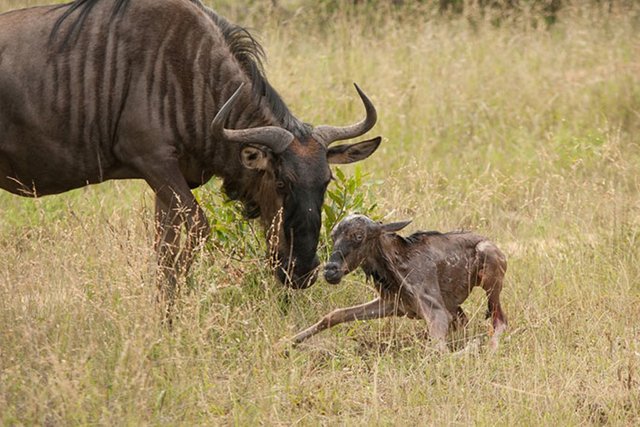
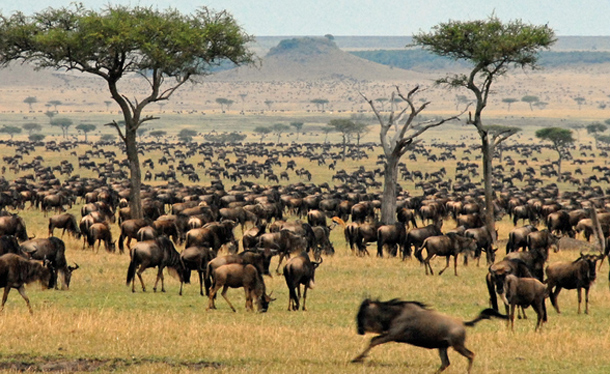
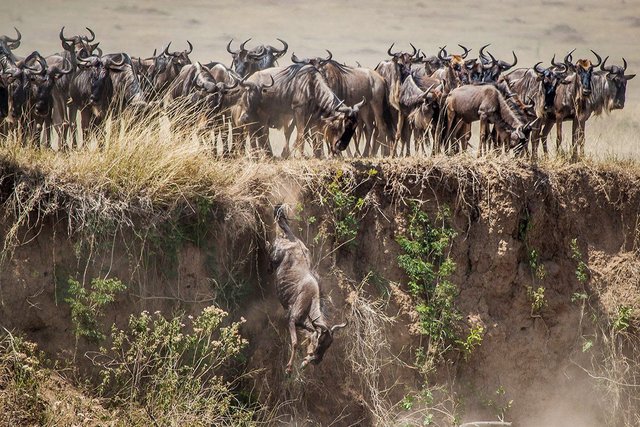
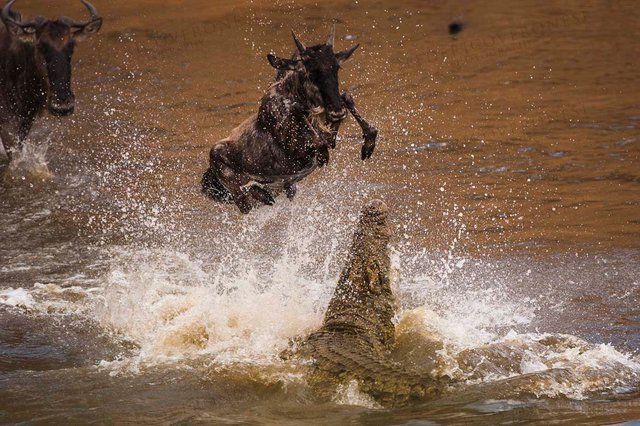
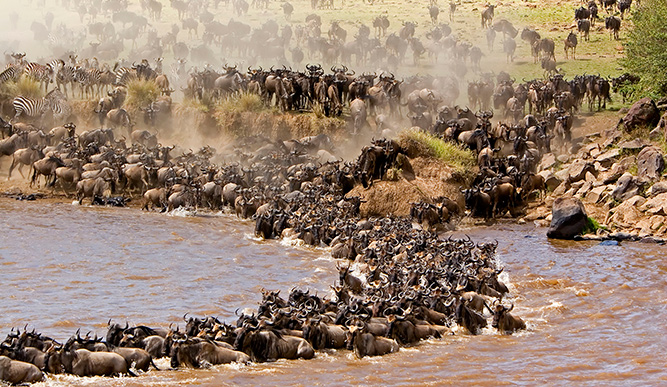

This post has received gratitude of 1.00 % from @jout
Downvoting a post can decrease pending rewards and make it less visible. Common reasons:
Submit
You got a 0.35% upvote from @postpromoter courtesy of @jout!
Downvoting a post can decrease pending rewards and make it less visible. Common reasons:
Submit
Your post was resteem by Whale ResteemService @booster007
Keep it up!
All the best!
First Follow for 3 hours | Send a minimum transaction 0.100 SBD with post URL in memo | Your post gets resteemed | A post can only be resteemed once!
Downvoting a post can decrease pending rewards and make it less visible. Common reasons:
Submit
40% upvoted
Downvoting a post can decrease pending rewards and make it less visible. Common reasons:
Submit
Magnificent content and images.
You're building our little Steemit-Wikipedia here!!
x
Downvoting a post can decrease pending rewards and make it less visible. Common reasons:
Submit
I love this. I have seen many such videos on youtube. It would be a dream come true to visit the amazing Serengeti!
Downvoting a post can decrease pending rewards and make it less visible. Common reasons:
Submit
Resteemed to over 6400 followers and 100% upvoted. Thank you for using my service!
Send 0.100 Steem or 0.100 Steem Dollar and the URL in the memo to use the bot.
Read here how the bot from Berlin works.
@resteem.bot
Downvoting a post can decrease pending rewards and make it less visible. Common reasons:
Submit
@originalworks
Downvoting a post can decrease pending rewards and make it less visible. Common reasons:
Submit
The @OriginalWorks bot has determined this post by @amavi to be original material and upvoted(1.5%) it!
To call @OriginalWorks, simply reply to any post with @originalworks or !originalworks in your message!
Downvoting a post can decrease pending rewards and make it less visible. Common reasons:
Submit
Downvoting a post can decrease pending rewards and make it less visible. Common reasons:
Submit
Yes yes yes!!! Such a great post!!! Natures Great Migrations is one of my favourite BBC series! This features, so jealous and happy for u that u got to see it! Great post! Will be resteeming!!!
Downvoting a post can decrease pending rewards and make it less visible. Common reasons:
Submit
Another excellent and descriptive Article. Love your work.
Downvoting a post can decrease pending rewards and make it less visible. Common reasons:
Submit
Another great, very informative knowledge enriching post. nice to someone so devoted to the story of nature life.
Downvoting a post can decrease pending rewards and make it less visible. Common reasons:
Submit
great migration
incredible photos thanks
Downvoting a post can decrease pending rewards and make it less visible. Common reasons:
Submit
I'll bet this is something to watch go by and watch for any amount of time.
Downvoting a post can decrease pending rewards and make it less visible. Common reasons:
Submit
That first picture of them all running in that massive herd looks like Walmart shoppers during Black Friday sales. Lol. Great post and amazing pics.
Downvoting a post can decrease pending rewards and make it less visible. Common reasons:
Submit
Incredible story of the cycle of life of the wildebeests. Fascinating how they know and repeat the same behaviors each year. Great read. Thank you.
Downvoting a post can decrease pending rewards and make it less visible. Common reasons:
Submit
What a great animal migration. Your post is quite intriguing, your pictures are so nice. Pls. Keep it up.
Downvoting a post can decrease pending rewards and make it less visible. Common reasons:
Submit